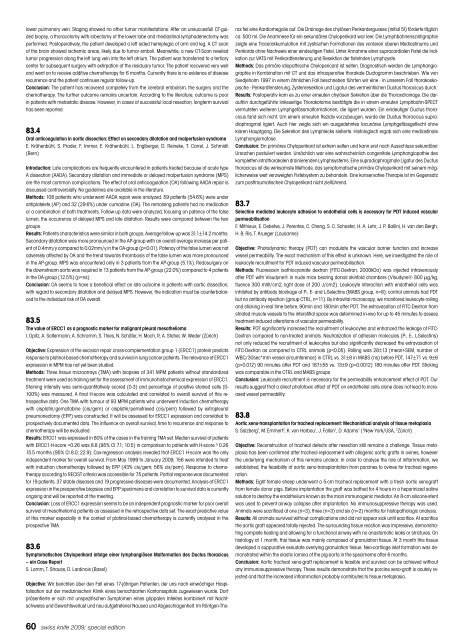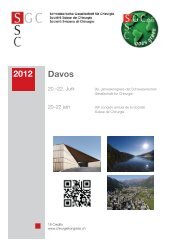Abstracts - Chirurgie Kongress
Abstracts - Chirurgie Kongress
Abstracts - Chirurgie Kongress
Create successful ePaper yourself
Turn your PDF publications into a flip-book with our unique Google optimized e-Paper software.
lower pulmonary vein. Staging showed no other tumor manifestations. After an unsuccesfull CT-guided<br />
biopsy, a thoracotomy with lobectomy of the lower lobe and mediastinal lymphadenectomy was<br />
performed. Postoperatively, the patient developed a left sided hemiplegia of arm and leg. A CT scan<br />
of the brain showed ischemic areas, likely due to tumor emboli. Meanwhile, a new CT-Scan reveiled<br />
tumor progression along the left lung vein into the left atrium. The patient was transferred to a tertiary<br />
center for subsequent surgery with extirpation of the residuary tumor. The patient recovered very well<br />
and went on to receive additive chemotherapy for 6 months. Currently there is no evidence of disease<br />
recurrence and the patient continues regular follow-up.<br />
Conclusion: The patient has recovered completely from the cerebral embolism, the surgery and the<br />
chemotherapy. The further outcome remains uncertain. According to the literature, outcome is poor<br />
in patients with metastatic disease. However, in cases of successful local resection, longterm survival<br />
has been reported.<br />
83.4<br />
Oral anticoagulation in aortic dissection: Effect on secondary dilatation and malperfusion syndrome<br />
E. Krähenbühl, S. Prader, F. Immer, E. Krähenbühl, L. Englberger, D. Reineke, T. Carrel, J. Schmidli<br />
(Bern)<br />
Introduction: Late complications are frequently encountered in patients treated because of acute type<br />
A dissection (AADA). Secondary dilatation and immediate or delayed malperfusion syndrome (MPS)<br />
are the most common complications. The effect of oral anticoagulation (OA) following AADA repair is<br />
discussed controversially. No guidelines are available in the literature.<br />
Methods: 108 patients who underwent AADA repair were analyzed. 59 patients (54.6%) were under<br />
antiplatelets (AP) and 32 (29.6%) under cumadine (OA). The remaining patients had no medication<br />
or a combination of both treatments. Follow-up data were analyzed, focusing on patency of the false<br />
lumen, the occurrence of delayed MPS and late dilatation. Results were compared between the two<br />
groups.<br />
Results: Patients characteristics were similar in both groups. Average follow-up was 31.1±14.2 months.<br />
Secondary dilatation was more pronounced in the AP-group with an overall average increase per patient<br />
of 0.4mm/y compared to 0.02mm/y in the OA-group (p



